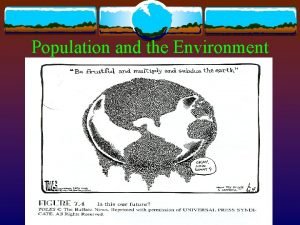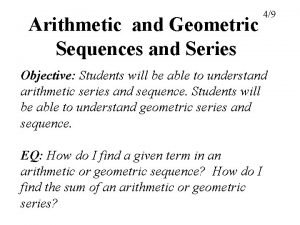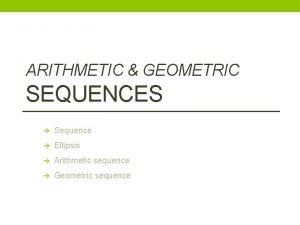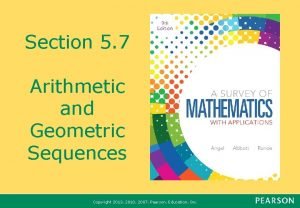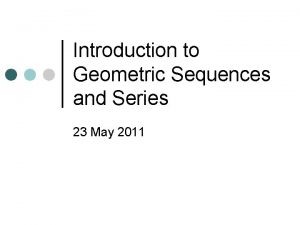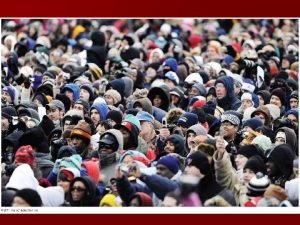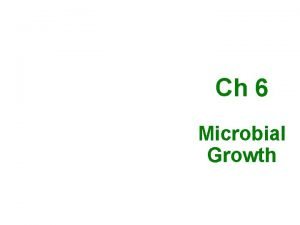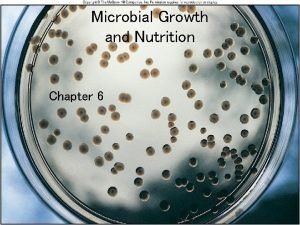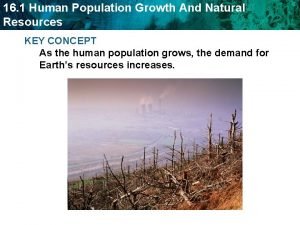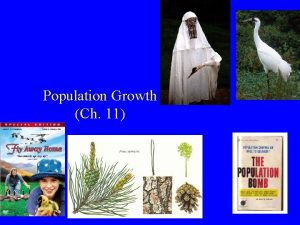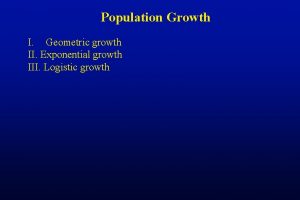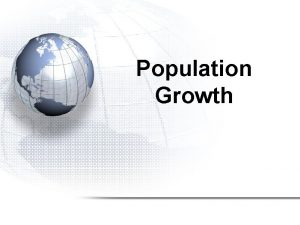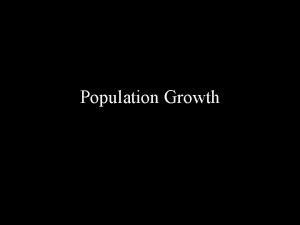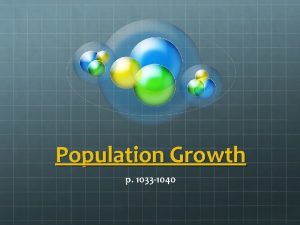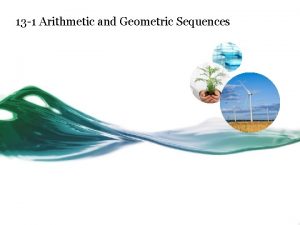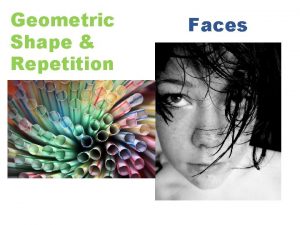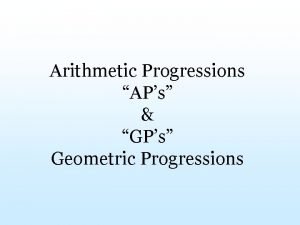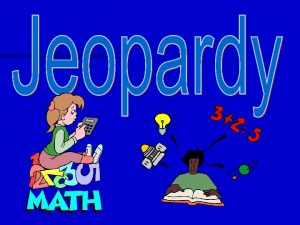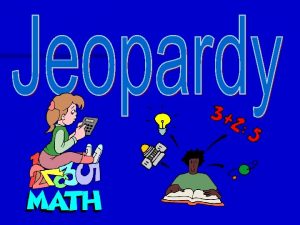Population and the Environment Arithmetic vs geometric growth

























- Slides: 25

Population and the Environment

Arithmetic vs. geometric growth • Arithmetic growth • • 1, 2, 3, 4, 5… Geometric growth (exponential) • 2, 4, 8, 16, 32… (Cunningham et. al: Environmental Science: A Global Concern)

Population growth • • 2 to 6, 600, 000 last century 1 B/decade 100 M/year 300 K/day 1 NYC/month 296 B in 150 years! (Cunningham et. al: Environmental Science: A Global Concern)

Carrying capacity • • Overshoot Dieback “crash” Increase w/ technology, but sustainable? What is Earth’s sustainable CC? (Cunningham et. al: Environmental Science: A Global Concern)

Fertility rates (replacement is 2. 1) (Rubenstein: Introduction to Human Geography)

Questions to think about • • • Why are we growing so fast? Why should we be concerned? People are good aren’t we? How does population affect the environment? What needs to be done? (Pojman: Population: General Considerations)

Growth causes • Higher fertility rate & lower death rate • Industrial Revolution • • Agricultural advances • • Fertilizer, irrigation & genetics Medical, health & sanitation revolution • • Fossil fuel & combustion engine Vaccines, antibiotics, nutrition, sewage, cleaner water, etc. Socioeconomic, religious & primal instinct factors (Newton and Dillingham: The Human Family Grows: Population as a Problem)

Malthus vs. Condorcet • • Geometric pop. growth Arithmetic subsistence growth Overshoot CC Starvation, disease & resource wars • • • Advance in technology = more improvement Moral advancement Women's rights (Pojman: Population and the Environment)

Optimist • • • More people = more brains = more progress Healthcare, economic opportunity & technology Creative resources are infinite (Newton and Dillingham: The Human Family Grows: Population as a Problem)

Pessimist • • More people = more pollution & global warming Irreplaceable resources • • Air, water, soil, species, etc. Agricultural & economic collapse Creative resources aren’t infinite Brains like Einstein or Mozart are very rare • Geniuses need education & food too (Newton and Dillingham: The Human Family Grows: Population as a Problem)

Current consequences • • Water depletion & pollution (33%) Soil degradation (43%) Deforestation Biodiversity • Extinction (27, 000/ yr. ) • • Famines Unemployment 2 B malnourished (½ children) Resource depletion • • US oil: 15 yrs World oil: 50 yrs (Newton and Dillingham: The Human Family Grows: Population as a Problem)

Overcrowding stress • • Intense competition Psychological, physical and behavioral changes Weakened immunity, aggression, cannibalism, arteriosclerosis and increased mortality Symptoms include abnormal adrenal glands & deterioration of circulatory system, kidney and liver (Cunningham et. al: Environmental Science: A Global Concern)

Women and population • • • Historically suppressed & regarded as inferior Men & religion control reproductive rights, education and career opportunity No independence • • Islam ”Men are above women because Allah has given the one superiority above the other” Confucius ”one hundred girls are not worth one boy” Hinduism ”A woman must never enjoy independence” Christianity ”The women shall be vassals to their men who are their masters”

Family planning • • • 97% of growth in poor nations with little access to reproductive services AID found many women want to limit pregnancies Funding cuts and “gag rule” (Cunningham et. al: Environmental Science: A Global Concern)

Consumption and the environment • • I = PAT Hunter gatherer • • Modern American • • 2, 500 calories 186, 000 calories Equivalent to sperm whale US most overpopulated in this context Rich vs. poor nations (Pojman: Population General Considerations )

Disproportionate consumption • • US has 4. 5% pop. Use 33% of all resources Produce 75% toxic waste & 33% total waste Produce the most greenhouse emissions • • Waste 200, 000 T edible food/d Eat 200 B extra calories/d (feed 80 million) 1/3+ overweight & spend $30 B/yr on diets Justifiable? (Pojman: Population General Considerations)

Death context 1. 3, 200 died tragically on 911 1. 2. 33, 000 children die/d unnecessarily from malnutrition and poverty-related disease 1. 2. 3. Relatively unpreventable Over $5 billion in aid Easily preventable 15 -25 cents/d would save the majority Political & religious authorities moral and pro-life? (Pojman: Hunger, Duty, and Ecology: On What We Owe Starving Humans)

Consumption of meat • Morality • • • Health • Death of animals & people 13 lbs. grain/ lb. meat 22 MT seeds produced in US, 20 MT fed to livestock 90% net loss 14 MT protein • • • Consumption increases risk of degenerative diseases Heart disease, obesity, diabetes & cancer Fat deposits in arteries of typical US child by age 3 & 70% by age 12 Greed & God? (Pojman: Hunger, Duty, and Ecology: On What We Owe Starving Humans)

Consumption solutions • • Progressive policies Simple • • • Reduce consumption Recycle waste Eat less meat Buy used stuff Don’t waste • Advanced • • Less children Invest in sustainable businesses Consider impact of decisions and actions Refocus reality away from material happiness

Population solutions • • • Halt & reverse growth to sustainable level Serious political & religious debate and reform Socioeconomic empowerment • • Educational & employment opportunities Social security systems Family planning services Environmentally sustainable development (Newton and Dillingham: The Human Family Grows: Population as a Problem)

Easter Island history • • Initially lush forest, fertile soil & abundant wildlife Overpopulation Deforestation Soil & water depletion Extinction of wildlife Chaos and warfare Cannibalism reduced population by 90% • • Why didn’t they control their population? Why didn’t they conserve their resources? Will we follow the same course? Should we be optimists, pessimists or both? (Cunningham et. al: Environmental Science: A Global Concern)

Henry Kendall of MIT- ”If we don’t control the population with justice, humanity, and mercy, it will be done for us by nature-brutally. ”

HIV/AIDS (Rubenstein: Introduction to Human Geography)

Mexican immigration • • Destabilize employment and economy? Overcrowding Higher resource and environmental pressures More native blood = more right to land & resources?

Religious leaders • • Hindu god Rama: two daughters Buddha: one son Jainism prophet Mahavira: one daughter Confucius: one son Taoism founder Loa-tzu: no children Moses: two sons Jesus Christ: no children Islamic prophet Mohammed: one daughter
 Arithmetically vs geometrically growth
Arithmetically vs geometrically growth Geometric growth population
Geometric growth population Arithmetic and geometric sequences and series
Arithmetic and geometric sequences and series Arithmetic and geometric scavenger hunt answer key
Arithmetic and geometric scavenger hunt answer key Explicet formula
Explicet formula Geometric series formula
Geometric series formula Recursive geometric formula
Recursive geometric formula How to identify an arithmetic sequence
How to identify an arithmetic sequence Geometric sequence formula
Geometric sequence formula Arithmetic and geometric formulas
Arithmetic and geometric formulas Lesson 3: arithmetic and geometric sequences
Lesson 3: arithmetic and geometric sequences Geometric series formula
Geometric series formula Geometric sequence
Geometric sequence Arithmetic sequences
Arithmetic sequences Geo sequence formula
Geo sequence formula Arithmetic and geometric patterns
Arithmetic and geometric patterns Circles geometric measurement and geometric properties
Circles geometric measurement and geometric properties Determine whether the sequence is arithmetic or not
Determine whether the sequence is arithmetic or not Arithmetic sequence formula
Arithmetic sequence formula Geometric sequence
Geometric sequence Geometric growth
Geometric growth Physiological density
Physiological density Incremental increase method questions
Incremental increase method questions Arithmetic vs exponential growth
Arithmetic vs exponential growth Arithmetic growth
Arithmetic growth Natural resources and population growth
Natural resources and population growth
